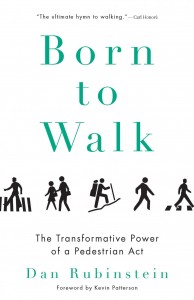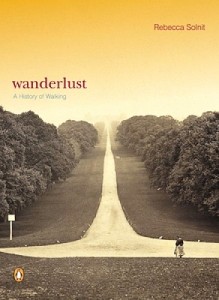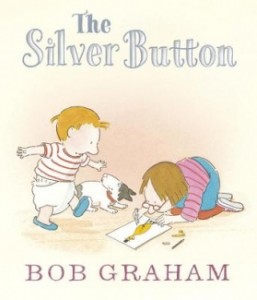April 8, 2015
Born to Walk by Dan Rubinstein
 I thought I’d already read the book on walking. Rebecca Solnit’s Wanderlust: A History of Walking is one of the most fascinating books I’ve ever read, a book that opened my eyes to the wonders of rambling and tramping, and to how amazing is the ordinary world around us all the time. How extraordinary is the act of a single step, let alone one after another.
I thought I’d already read the book on walking. Rebecca Solnit’s Wanderlust: A History of Walking is one of the most fascinating books I’ve ever read, a book that opened my eyes to the wonders of rambling and tramping, and to how amazing is the ordinary world around us all the time. How extraordinary is the act of a single step, let alone one after another.
However extraordinary though, we are talking about walking. After Wanderlust, what else needs to be said? So I wasn’t entirely sold on Dan Rubinstein’s Born to Walk: The Transformative Power of a Pedestrian Act—not at least until I opened the book. I saw that Rebecca Solnit was his epigraph (“Perhaps walking is best imagined as an ‘indicator species’ to use an ecologist’s term…”). And realized that the journey, delightfully, continues on.
Whereas Solnit’s book was a history of walking, Rubinstein spreads his net wide and attempts to capture walking right now. What does it mean? How is walking changing lives and places? The book is divided into eight sections—Body, Mind, Society, Economy, Politics, Creativity, Spirit and Family—each one inspired by a central walking narrative with plenty of room for diversions. Rubsinstein, an award-winning journalist, blends memoir, sociology, psychology, cultural commentary and reporting to show how walking connects us to our fundamental selves and also to the natural world.
In “Body”, he journeys with a team led by Dr. Stanley Vollant, an Innu surgeon whose days-long hikes through the remote wilderness reconnects First Nations people with the lives their ancestors led before communities in Northern Canada became settled, hikes that are tests of physical and spiritual strength. (Aside: a quietly groundbreaking study published in 1953 asserting that “regular physical exercise could be one of the ‘ways of life’ that promote health.” More asides: modern labs which study how and why people fall, attempting to create safer stairs—”In Canada, the social and health-care cost of accidents on stairs alone is estimated at $8.8 billion a year.” An exoskeleton that enables paralyzed people to walk. So many asides: this is a text rich and enlivened by desire lines…)
In “Mind,” Rubinstein considers “The Glasgow Effect”—Glasgow has the lowest life expectancy in Western Europe, increased circumstances of psychiatric disorders—and examines programs to counter this effect including neighbourhood walks and connecting people with natural places. This chapter also uses examples of war veterans with PTSD, and the effect of hikes upon their wellbeing. In “Society,” Rubinstein travels the streets of Philadelphia with Police Officers on foot patrol, invokes Jane Jacobs, and demonstrates how different one’s experience of a city is when lived through a car window, or as part of the sidewalk ballet.
 My adoration for Born to Walk was cemented with the chapter on “Economy,” which begins with a Canada Post letter carrier making her rounds in Ottawa. What do these kind of individuals offer Jacobs’ sidewalk ballet? And are people who walk for a living happier and healthier than the rest of us? Canada Post is phasing out home delivery, although they made a profit last year and their parcel delivery service is robust due to online retailers such as Amazon. Amazon, not yet fully automated—pickers at their warehouses walk 7 to 15 miles a day, Rubinstein tells us, shifting then to ask what a lack of walking costs us economically, what might be gained by created walking and cycling infrastructure. And what about the possibilities of walking and business? He addresses the walk-around management style, and the idea of walking-meetings. He also interviews two owners of a small dog-walking business. “It pays well and it’s only a half day, so I can also work on other things that I’m interested in… And yeah, the walking. That’s probably the best part.”
My adoration for Born to Walk was cemented with the chapter on “Economy,” which begins with a Canada Post letter carrier making her rounds in Ottawa. What do these kind of individuals offer Jacobs’ sidewalk ballet? And are people who walk for a living happier and healthier than the rest of us? Canada Post is phasing out home delivery, although they made a profit last year and their parcel delivery service is robust due to online retailers such as Amazon. Amazon, not yet fully automated—pickers at their warehouses walk 7 to 15 miles a day, Rubinstein tells us, shifting then to ask what a lack of walking costs us economically, what might be gained by created walking and cycling infrastructure. And what about the possibilities of walking and business? He addresses the walk-around management style, and the idea of walking-meetings. He also interviews two owners of a small dog-walking business. “It pays well and it’s only a half day, so I can also work on other things that I’m interested in… And yeah, the walking. That’s probably the best part.”
In “Politics,” Rubinstein walks with Rory Stewart, a British MP who got to know his constituents by hiking around Northwestern England, going door to door, the same way he’d got to know Afghanistan in 2002, after leaving behind his job in the Foreign Service. (His journeys through Afghanistan culminated in his book, The Places in Between.) The chapter invokes Thoreau, Gandhi, marches on Washington for woman’s suffrage and for civil rights, and First Nations walks in protest in Canada.
In “Creativity,” he takes part in walking as performance art in Brooklyn, considers artists for whom walking as served as muse or medium, and learns about the role of walking in creative cognition. In “Spirit,” he partakes in a hike through Wales, and writes about famous pilgrimages including El Camino in Spain, the Hajj in Mecca and the Kumbh Mela in northern India. He writes about what it means to finish a pilgrimage…and what it means to quit. And the final chapter is “Family,” in which he writes about walking to school with his children—particularly after they were mowed down by an SUV (and it’s always an SUV, isn’t it?) at their local crosswalk. What can we do to make streets safer for children to walk to school, for everyone to walk safely? He cites surprising benefits to walking to school—not just time for conversation and physical fitness, but studies showing that children who walk to school are more deeply connected to their communities geographically and psychologically. And he writes about walking with his children, hikes through nature—how this has always been part of their experience as a family. What it gives them: time, the moment, right now.
And that’s the thing about walking—these vast ramifications, but it often comes down to a little hand in yours, always ordinary until it comes to a tiny person’s miraculous first step.
In our family, we don’t have a car, and so the decision to walk to school isn’t one we ever have to think about. A few times a year, they have a “Walk to School Day” at the school, and we think this is funny, the same way I thought it was funny when someone declared 2014 the year to read women writers. Last year when I wrote about the Rebecca Solnit book (and its companion—the picture book The Silver Button by Bob Graham), Harriet was only 4 and finding the walk to school a bit of a struggle, whereas her legs are longer now and she’s used to it—particularly when she’s unencumbered by snow pants, the walk is not a slog at all. “I was born to walk,” she told me this morning, because she is impressionable, and can read book jackets now, and I’ve been talking a lot about this one. It’s a book whose connections to the world are so multitudinous that you keep putting it down as you’re reading to share something fascinating, and then when the book is done, you go out walking down the street, and the connections all come back to the other way.
Iris, who is not quite 2, is a different creature than her sister was, bipedally speaking. She wants to walk everywhere, shouting “Walkie! Walkie!” if we dare constrain her in her stroller, and she doesn’t just want to walk—she does walk. Last Tuesday, she walked down Bloor Street from Spadina to Bay. It’s her favourite thing in the world—she seems to know everything in Rubinstein’s book innately—to be motoring on her own steam, and so completely free.







Thanks so much for writing about this one, Kerry — it’s a pleasure to read, as always.
I’m so excited about this one; it really is hard to stop talking about, but I’m glad I’ll be able to discuss it with people now, instead of just rambling at them about it!
I also felt deeply about Wanderlust, and your review of Born to Walk articulates so many things I feel about the joys of walking, I can’t wait to get my hands on it!
Lovely post. Must get this book. We’re a car-free family, and trample happily all over the city.
Rubinstein just gets it, doesn’t he? I’m a die hard walker and he articulates so much of what i believe so well. Loved this book.
It was really terrific. Keeps running through my mind!
Born To Walk articulates what I love about the act of walking, and why I love it. And it delineates what humanity needs in order to create and sustain walkable, livable cities and towns. I also value Rubenstein’s mentions of others’ concepts, i.e., soft fascination (Kaplans), slow living (Honoré). Since finishing it, referring to Rubenstein’s bibliography for titles I might explore, I’ve read Walkable City, The Walkable City, The Places in Between. After walking, I suppose reading’s what I enjoy most. Although, movies. Have you seen Tracks?